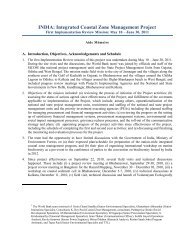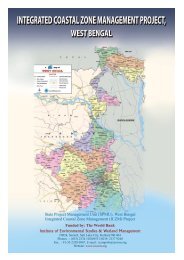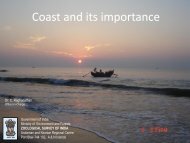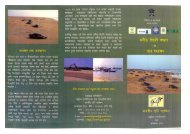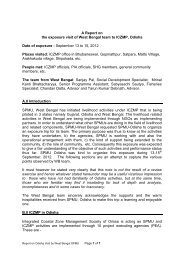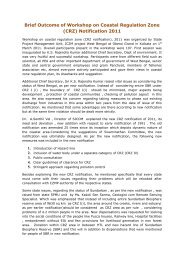Cyclone and Storm Surge - Iczmpwb.org
Cyclone and Storm Surge - Iczmpwb.org
Cyclone and Storm Surge - Iczmpwb.org
You also want an ePaper? Increase the reach of your titles
YUMPU automatically turns print PDFs into web optimized ePapers that Google loves.
2.23<br />
2.4.10. Flora <strong>and</strong> fauna<br />
The Natural Forest Resources consists of the mangrove forests which constitute a major resource in<br />
terms of the area, density <strong>and</strong> diversity of mangrove species they contain. In this Division the forest<br />
area consists of many low flat isl<strong>and</strong> called locally as "Char L<strong>and</strong>' <strong>and</strong> mud banks separated by a<br />
network of anastomotic channels <strong>and</strong> rivers, the courses of which are very much prone to frequent<br />
alteration. There is a dynamic state of erosion in some areas <strong>and</strong> creation of new mud banks <strong>and</strong><br />
char l<strong>and</strong> in others.<br />
The vegetative colonisation of newly formed l<strong>and</strong> follows the pattern of natural succession. At first,<br />
pioneer species establish on the site. In the case of mangroves, the seeds of these species are<br />
dispersed by water, floating in on the high tides <strong>and</strong> lodging in the soft mud as the tide recedes.<br />
Species of Avicennia, Rhizophora, <strong>and</strong> Sonneratia are the typical mangrove pioneers. These<br />
pioneers are adapted to the diurnal inundation by the tides, <strong>and</strong> in fact, depend upon it. As they grow<br />
they induce further sedimentation by reducing the velocity of water flowing past <strong>and</strong> trapping silt. As<br />
the sedimentation build up <strong>and</strong> the duration <strong>and</strong> frequency of inundation reduces, other species like<br />
Bruguieria, Xylocarpus, Exoecaria etc, are established. Like other natural forest succession, the<br />
pioneers are comparatively faster growing but shorter living than species coming later ion the<br />
sucession.<br />
Where the accretion of the sediment reaches a level where the tidal inundation is rare, the vigor <strong>and</strong><br />
regenerative capacity of the mangrove species fade away. These types of l<strong>and</strong> tend to become<br />
dominated by a low thicket palm like Phoenix paludosa. Besides the frequency <strong>and</strong> duration of tidal<br />
inundation, salinity level plays a major role in influencing the occurrence of mangrove species. As a<br />
result of change in salinity profile the occurrence of species like Sundari (Heritiera fomes) has<br />
become less since it is sensitive to change in salinity level.<br />
With the progress of reclamation in the Sundarbans <strong>and</strong> increase in human population, the wild life is<br />
faced with gradual extinction. The most noted species are Royal Tiger, Cheetal (Spooted dear) <strong>and</strong><br />
the Crocodiles. In Sundarbans tigers very often carry away wood-cutters, honey collectors <strong>and</strong> others<br />
from the forest area. They are great swimmers <strong>and</strong> there are instances that they carry away men<br />
from boats anchored in mid stream. The crocodiles in Sundarbans known as Estuarine Crocodiles<br />
(Crocodilus Porosus) are also man eater.









